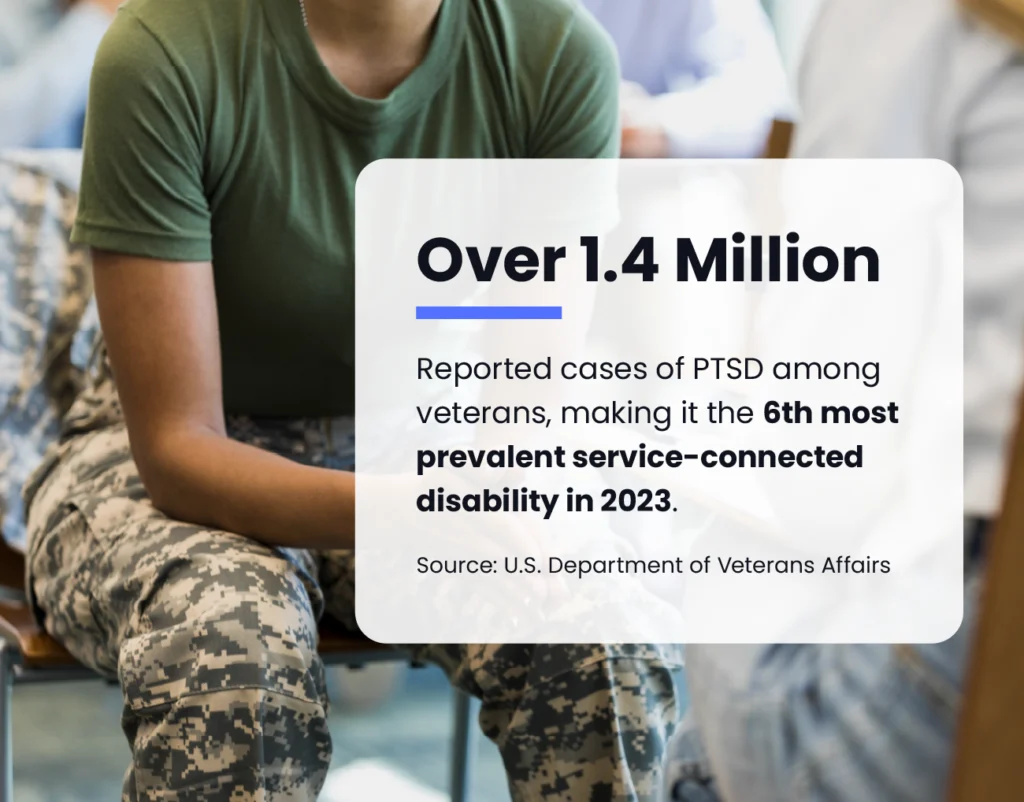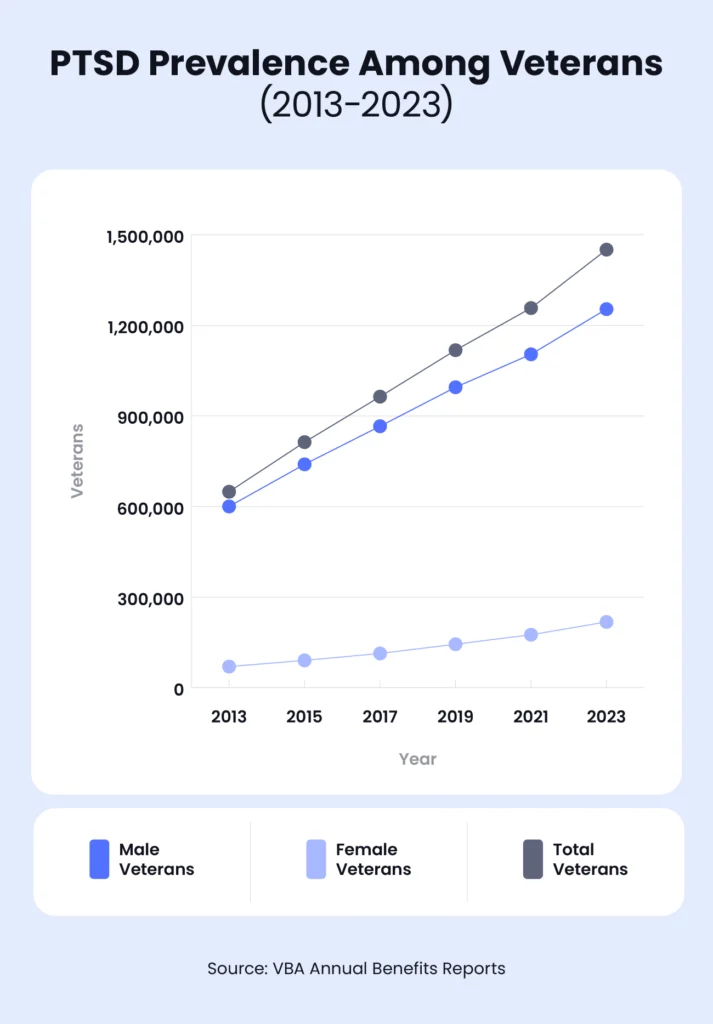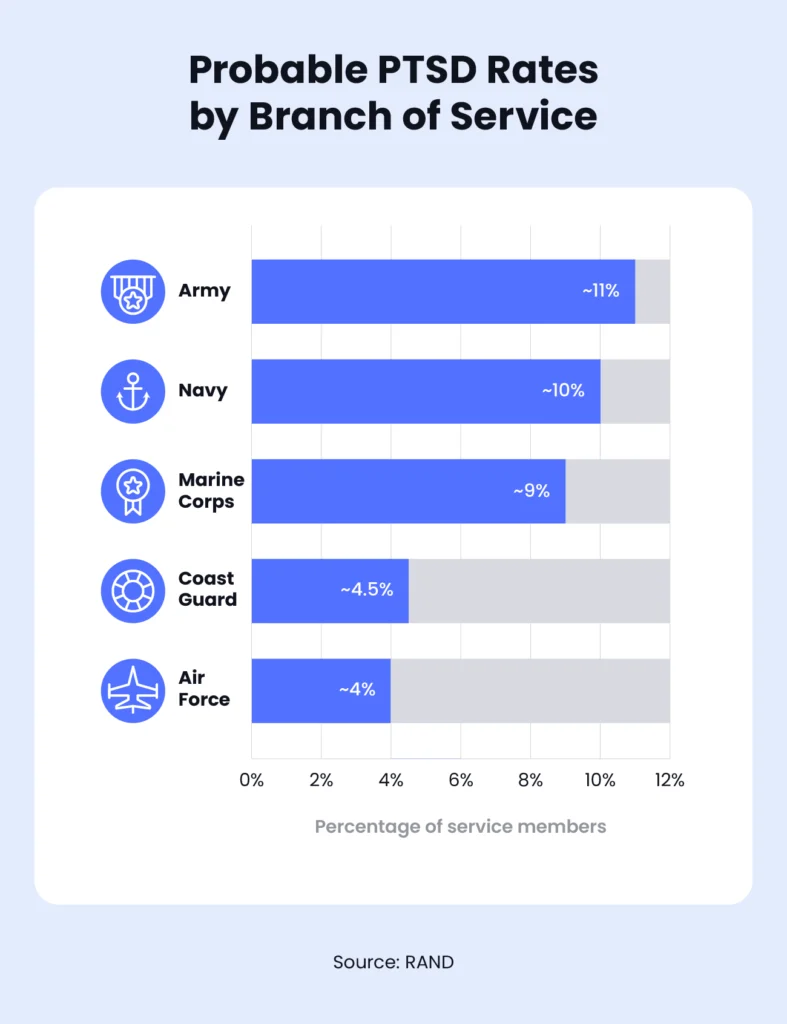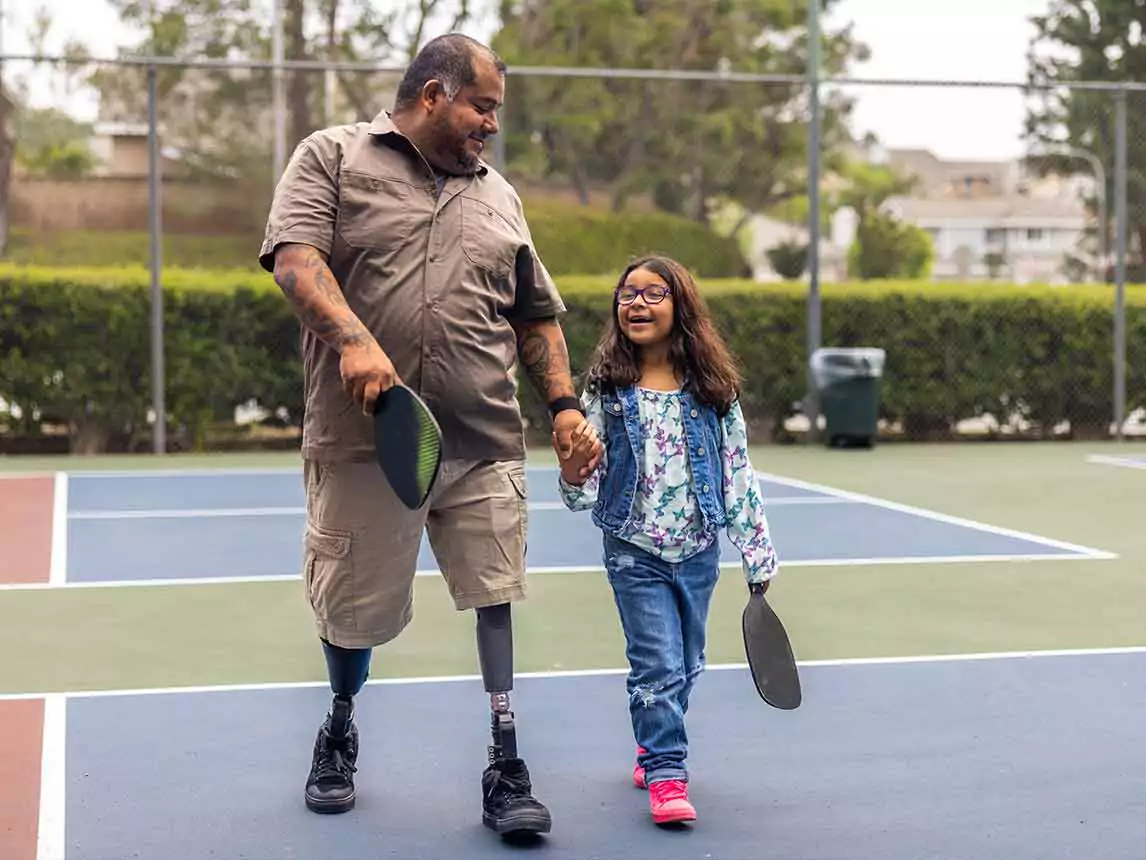Out of the general population, veterans are the most likely group to experience post-traumatic stress disorder (PTSD). In fact, it’s one of the most common disability claims made by veterans.
This isn’t surprising considering the nature of their service. Exposure to combat, witnessing traumatic events, and the stress of military life can all contribute to developing this mental health condition.
In this post, we’ll delve into the most recent veteran PTSD statistics, offering an overview of its prevalence across different eras of service, military branches, and demographics. We’ll also explore the nature of PTSD, common symptoms, and the research-backed PTSD treatments available to veterans.
Table of contents:
- How Common Is PTSD in Veterans?
- Causes of PTSD Among Veterans
- Effective Treatments for PTSD in Veterans
- Learn More About Your VA Disability Eligibility
How Common Is PTSD in Veterans?
While PTSD affects a portion of the general population, with approximately 6% experiencing it at some point in their lives, veterans are significantly more likely to develop this condition.
Estimates of PTSD prevalence among veterans vary due to different research methodologies and evolving definitions of PTSD over time. However, to provide a clearer picture of its prevalence in this population, we’ve compiled the following statistics from studies conducted in the past few years.

VBA Annual Benefits Report (2023)
Among the veterans who established a service connection and filed for disability in 2023:
- PTSD was the sixth most prevalent service-connected disability in 2023.
- The total number of reported post-traumatic stress disorder cases in 2023 was 1,451,153.
- There’s been an 8% increase in PTSD cases between 2022 and 2023.
- Over 1.25 million men claimed to have PTSD in 2023.
- 185,980 women claimed to have PTSD in 2023.
- There’s been a 124% increase in PTSD cases among veterans since 2013.
| Year | Total Veterans | Male Veterans | Female Veterans |
| 2013 | 648,992 | 600,193 | 38,076 |
| 2015 | 813,277 | 739,808 | 58,659 |
| 2017 | 964,038 | 866,005 | 81,546 |
| 2019 | 1,118,041 | 995,189 | 112,144 |
| 2021 | 1,257,631 | 1,104,385 | 143,565 |
| 2023 | 1,451,153 | 1,254,181 | 185,980 |
Source: U.S. Department of Veterans Affairs

U.S. Department of Veteran Affairs Report (2021)
Among the 6 million veterans served by the VA in fiscal year 2021:
- 600,000 men (or 10%) were diagnosed with PTSD.
- 1.14 million women (or 19%) were diagnosed with PTSD.
Source: National Center for PTSD
National Health and Resilience in Veterans Study (2019-2020)
In an online survey of a nationally representative sample of U.S. military veterans:
- The weighted prevalence of lifetime PTSD was 9.4%.
- The prevalence of current PTSD among veterans was 5% overall.
- PTSD was more common among female veterans (11%) compared to male veterans (4%).
Source: NHRVS
Prevalence of PTSD by Era of Service
The number of veterans with PTSD varies by service era. The 2023 VBA Annual Benefits Report recorded the number of PTSD cases by period of service:
| Service Era | War | Total Number of Veterans with PTSD | Percentage of Veterans with PTSD |
| Persian Gulf War (Desert Storm) | The Gulf War(1991) | 992,104 | 3.5% |
| Peacetime Era | No Conflict(1975-1990) | 69,037 | 2.2% |
| Vietnam War | The Vietnam War(1962-1973) | 384,186 | 6.4% |
| Korean War | The Korean War(1950-1953) | 4,684 | 3.2% |
| Word War II | World War II(1939-1945) | 1,142 | 4.2% |
The National Center for PTSD also gathered data from a large study of veterans across the country to find the prevalence of PTSD from the War in Iraq and War in Afghanistan.
- 29% of veterans who served in the Operation Iraqi Freedom (OIF) and Operation Enduring Freedom (OEF) were diagnosed with PTSD at some point in life.
- 15% of veterans who served in the OIF and OEF were diagnosed with PTSD in the past year.
It’s important to note that other data suggests higher rates of PTSD among veterans of different service eras. For example, a 2011 survey by Pew Research Center found that 37% of veterans serving in the War in Iraq and War in Afghanistan reported suffering from post-traumatic stress syndrome.
Prevalence of PTSD by Service Branch
PTSD rates can vary depending on the branch of service. Each military branch has different experiences, like being deployed to a war zone, which significantly increases the risk of PTSD.
A Health Related Behaviors Survey conducted in 2015 measured probable PTSD by service branch. The survey found the following rates:
- Army: ~11%
- Navy: ~10%
- Marine Corps: ~9%
- Coast Guard: ~4.5%
- Air Force: ~4%

Risk Factors for PTSD
Researchers have investigated risk factors associated with PTSD in military personnel and veterans. A 2015 meta-analysis of 32 studies found that the prevalence of PTSD varied widely, ranging from 1.09% to 34.84%.
Several factors were associated with an increased risk of PTSD, including:
- Serving in the army
- Lower education level
- Prior psychological problems
- Female sex
- Enlisted rank (compared to officers)
- More deployments
- Longer cumulative deployment length
- Experiencing adverse life events
- Prior trauma
It’s important to note that results varied across studies, highlighting the complexity of PTSD risk factors.
Causes of PTSD Among Veterans
Those who serve in the military experience various traumatic events that can trigger PTSD. The National Health and Resilience in Veterans Study (NHRVS) found that exposure to the following situations contributed to the probability of lifetime PTSD:
- Hit or kicked hard enough to injure: 23.4%
- Suddenly abandoned by a loved one: 20.2%
- Traumatic combat exposure: 18.8%
- Attacked with a gun, knife, or weapon: 18.7%
- Saw something horrible or was badly scared during service: 18%
- Seeing someone die suddenly or badly hurt: 13.5%
- Experiencing a life-threatening illness or injury: 10.7%
Military Sexual Trauma and PTSD
Military sexual trauma (MST) is defined as any sexual harassment or sexual assault that occurs while serving in the military. It can happen to anyone, regardless of gender, and can occur during peacetime, training, or wartime.
Studies show a strong link between MST and PTSD. A study by the NHRVS found that experiencing forced sexual contact is a significant risk factor for developing lifetime PTSD, affecting over 37% of veterans in the study.
While MST can affect anyone in the military, it’s significantly more prevalent among women. Data from the National Center for PTSD shows a stark disparity:
- Approximately 1 in 3 women veterans report experiencing MST when screened by their VA provider.
- In comparison, only 1 in 50 male veterans report the same.
While this shows a big difference, it’s important to consider that other factors such as underreporting of MST by men and potential differences in coping mechanisms between sexes may also play a role in this disparity.

Effective Treatments for PTSD in Veterans
PTSD can have a major impact on your life. Thankfully, there have been various studies to help find effective treatments for PTSD, specifically for veterans. Here are a few effective treatments for PTSD.
Evidence-Based Therapies
According to the U.S. Department of Veterans Affairs, evidence-based therapies are among the most effective treatments for PTSD. They can include:
- Cognitive processing therapy (CPT): Helps veterans understand how trauma affects their thinking, challenge negative thoughts, and develop healthier beliefs
- Prolonged exposure (PE) therapy: Helps veterans gradually confront traumatic memories and feelings to reduce PTSD symptoms
- Cognitive-behavioral conjoint therapy (CBCT): Helps couples understand how PTSD affects their relationship and improves communication; veterans may also experience positive changes in their thoughts and beliefs
- Eye movement desensitization and reprocessing (EMDR): Helps process and make sense of trauma by focusing on the memory while using eye movements or sounds
Mindfulness-Based Stress Reduction (MBSR)
Mindfulness-based stress reduction (MBSR) is an evidence-based approach to managing stress and its associated symptoms. This program cultivates present-moment awareness through meditation practices, fostering emotional regulation and reducing rumination.
Research has shown that MBSR can be beneficial for veterans with PTSD. A study investigating its effects found that MBSR led to:
- Improved PTSD symptoms
- Increased mindfulness, potentially linked to enhanced spiritual well-being
- Changes in brain activation patterns during exposure to trauma reminders
These findings suggest that MBSR may alter brain function in a way that reduces fear and stress responses in individuals with PTSD.
Psychiatric Assistance Dogs (PADs)
According to research from 2022, 31% of veterans with psychiatric assistance dogs no longer met the clinical criteria for PTSD after 15 months.
While this finding suggests that PAD placement is associated with a decrease in PTSD symptoms, it’s not a cure and shouldn’t be considered a standalone treatment.
Delivery Preferences for PTSD Treatment
An article in Military Medicine sought to find the preferred treatment delivery for veterans with PTSD. The study concluded that:
- 42% of veterans preferred home-based treatments — treatments received at the veteran’s home without the physical presence of a health care professional.
- 32% of veterans preferred in-home in-person treatments — treatments received at the veteran’s home with the physical presence of a health care professional.
- 26% preferred office-based telehealth treatments — treatments received remotely through video conferencing or other digital platforms from a health care professional’s office.
Less than 50% of the sample preferred one method, suggesting that one treatment modality does not fit all.
Learn More About Your VA Disability Eligibility
Understanding your VA disability eligibility is crucial, especially considering the prevalence of PTSD among veterans. Don’t hesitate to take the next step by finding your PTSD VA rating and taking our Benefits Quiz to discover the specific benefits you may qualify for.
 Benefits.com Advisors
Benefits.com Advisors
With expertise spanning local, state, and federal benefit programs, our team is dedicated to guiding individuals towards the perfect program tailored to their unique circumstances.
Rise to the top with Peak Benefits!
Join our Peak Benefits Newsletter for the latest news, resources, and offers on all things government benefits.




















